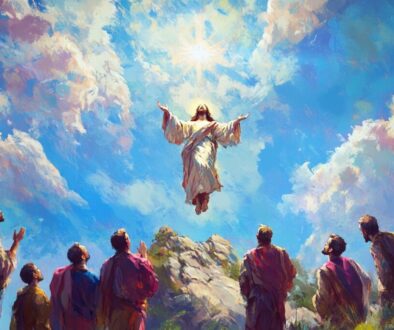The Food That Sustains The Sacrificial Journey – 19th Sunday in Ordinary Time – Sermon by Father Levine

Fr. Joseph Levine; Holy Family Catholic Church and Missions, Burns, Oregon; August 11, 2024
Today’s 1st reading shows us the prophet Elijah on a desert journey to the mountain of God. The prophet’s journey stands as a symbol of the journey that every Christian must make to reach the supreme goal of life, union with God in heaven. There are some who have not even started on this journey; there are some, who like the prophet in today’s 1st reading, have given way to discouragement; there are some who are making good progress. All of them need the food for the journey, the Bread that came down from heaven to lift us up to heaven.
The desert journey passes by way of Jesus Christ and his Cross, for he said, I am the way, and the truth, and the life, no one comes to the Father, except through me. (Jn 14:6) It is a desert journey because for our senses, our imagination, and our emotion, it is fundamentally “dry” and devoid of satisfaction, for this journey requires the continual renunciation of what we see so as to travel by faith, which looks to what we cannot see. We walk by faith, not by sight. (2 Cor 5:7; cf. He 11:1) We look not to the things that are seen but to the things that are unseen; for the things that are seen are transient, but the things that are unseen are eternal. (2 Cor 4:18)
We cannot see the godhead of the man Jesus Christ and indeed now we cannot even see his glorified humanity, really, truly, and substantially present in the Holy Eucharist.
Nevertheless, as the Israelites, on their desert journey were given water from the rock and the manna, on our desert journey we are sustained by the visible sacraments, above all the most Holy Eucharist. Yet, while we can see the sacrament, which is a sign, only faith perceives the unseen reality. We can see the appearance of bread and wine, but only faith recognizes the reality of the Body and Blood of Christ. Faith in the humanity of Jesus, hidden in the sacrament is the path to the vision of his divinity, which he shares with the Father.
Wherever we are on the journey we must go by way of Jesus Christ who said, No one can come to me unless the Father who sent me draw him. We must then continually beg the Father to draw us to his Son, Jesus Christ, to draw us in particular to Jesus Christ in the Holy Eucharist. Those whom the Father draws are drawn not just to participate in the sacrifice of the Mass, not just to holy communion, but also they are drawn to Jesus in Eucharistic adoration – indeed, before we receive communion we must in some fashion express adoration with our body. In prolonged Eucharistic adoration, we are taught not just by the word that sounds upon the ear and enters the mind, there God teaches us through his Holy Spirit in the depth of our heart, whispering what exceeds all that the mind can grasp, and opening our inner hear to hear Jesus himself say to us, I am the bread of life … I am the living bread that came down from heaven.
Taste and see the goodness of the Lord. In eucharistic adoration we prolong, as it were the experience of holy communion, we prolong as it were our sharing in the holy sacrifice, and that prolongation enables us to taste and savor the Lord’s goodness in a way that often escapes us at Mass.
Yet, if we only go through the motions, if we show up only with our body, we will not be able to enter into and taste that inner invisible reality. We must travel on the road that includes the whole of our daily life. It is a road upon which we must strive to be imitators of God as beloved children. This means recognizing the sacrificial offering of Jesus Christ and making of our lives also a sacrificial offering.
Let me pause there for a moment: what is a sacrificial offering? What does the word “sacrifice” even mean? This is important because the word today is often reduced to self-renunciation and the acceptance of pain, giving something up. People speak of “sacrificial love”, loving until in hurts, putting myself in second place for the sake of someone I love. One key word is missing: “God”.
Yes, in a world marked by sin, renunciation and pain are intertwined with sacrifice; yes, love must be the “engine” that drives sacrifice. What we have lost, however, is that sacrifice first and foremost has to do with our relation to God and properly speaking sacrifice is rightly offered only to God; otherwise it would be idolatry. A husband can offer himself as a sacrifice to God on behalf of his wife, but he must not sacrifice himself to his wife.
Sacrifice first and foremost has to do with giving to God, our Creator and Lord, the unique and supreme honor that is his due because he is God. It is the most fundamental duty of his creation, but one that will be experienced merely as a burden unless we love him and desire to please him.
Sacrifice has an interior and exterior element.
The interior, the heart of sacrifice, consists in adoration, the unconditional loving surrender to God, offering ourselves to him, placing ourselves at his disposal, that he might do with us as he pleases. It means placing ourselves without any reservations at his service. The interior spirit of sacrifice says, “God, you are my God, I present myself before you, I place myself in your hands, do with me what you will.” Jesus embodied this spirit of sacrifice on his first entrance into the world when he said in the presence of the Father, citing the Psalmist: Lo, I have come to do thy will, O God. (He 10:7) The Blessed Virgin gave expression to this spirit of sacrifice when she replied to the angel: Behold, the handmaid of the Lord, be it done to me according to your word. (Lk 1:38)
What lies hidden in the heart needs an outward expression. The exterior element of sacrifice – which is needed also for sacrifice to become a common, public act – involves a gift of tribute to God, a gift which is symbolic and expressive of the self-offering that lies at the heart of sacrifice, a gift not according to our manner or choosing, but according to God’s manner and choosing, according to his law. In the time of the Old Testament, there was a prescribed ritual of animal sacrifice, the offering of bulls, lambs, and goats, as symbols of self-offering. The death and destruction of the animal symbolized both the transference of the animal from human possession and use to God’s realm and also the desire to pay the debt of sin. The painful aspect of sacrifice arises precisely from the need to atone for sin before God.
Yet, all those sacrifices were imperfect symbols because it is impossible that the blood of bulls and goats should take away sin. (He 10:4) Instead, Jesus Christ, on the Cross loved us and handed himself over for us as a sacrificial offering to God for a fragrant aroma. On the Cross, Jesus made of his whole life, expressed by his Body, a gift in honor of God and in expiation for sin. Because he is the Son of God, consubstantial to the Father, this was truly worthy worship, more than adequate expiation; this was God, as man, worshipping God, on our behalf. This is the gift of his flesh for the life of the world.
At the Last Supper, he anticipated that offering in ritual fashion when he instituted the Holy Eucharist and then, saying do this in memory of me, he entrusted that offering to his Church, through his Apostles, so that we might be able to share in Christ’s worship of the Father, and offer ourselves, sanctified by the waters of baptism, through, with, and in him. What a gift!
Jesus’ gift to his Church of perfect sacrificial worship needs to become the pattern of our life. We must become imitators of God as beloved children. So St. Paul exhorts us by the mercies of God … to present our bodies as a living sacrifice, holy and acceptable to God, our reasonable worship. (cf. Rm 12:1) And, Whatever you do, in word or deed, do everything in the name of the Lord Jesus, giving thanks to God the Father through him. (Col 3:17)
Everything we do, in word or deed, must become an offering to God through Jesus Christ.
Alas, we find much in ourselves that is not at all pleasing to God. So the first step in the sacrificial life is turning away from sin and rejecting the impulse to sin. All bitterness, fury, anger, shouting, and reviling must be removed from you. “Offer it up!” When we bite our tongue, when we reject the temptation to bitterness, when we learn to master our anger, this should not just be a matter of “self-improvement” or of learning to get along with others, rather the deepest and strongest motive should be to make an offering to God, seeking to please him. So also, when we learn to be kind, compassionate, and forgiving to others. We must in all this follow Jesus Christ who said, I always do what pleases the Father. (Jn 8:29)
The desert journey to union with God is essentially an interior journey, a journey of the heart, a sacrificial journey.
Get up and eat, else the journey will be too long for you.
We need food in order to make this journey, food to reach God, food that will nourish a life that does not die. That food is the fruit of Christ’s sacrifice, his Body and Blood in holy communion.
Now, even someone who is in a state of mortal sin, deprived of the grace of God, should come to Mass to be present for Christ’s sacrifice, to beg the grace of repentance and conversion of heart, but so long as he remains in sin, he lies asleep like the prophet.
We must get up through repentance and confession of our sins, then we must eat of the true manna, the bread the Lord has given us, his own flesh for the life of the world. In that strength we are able to journey to the mountain of God.
Seek a Deeper Connection with God and Join Lay Cistercians of South Florida
Lay Cistercians of South Florida, is a community of lay people who seeks to have a deeper connection with God by living a life inspired by the monks and nuns through Lay Monasticism. Learn more about what is a Lay Cistercian on our website. Anyone who aspires to do the same as us, and is a confirmed Catholic is welcome to join us! We meet every second Saturday of the month at Emmanuel Catholic Church in Delray Beach, Florida.

This Content Has Been Reviewed For Accuracy
This content has undergone comprehensive fact-checking by our dedicated team of experts. Discover additional information about the rigorous editorial standards we adhere to on our website.



